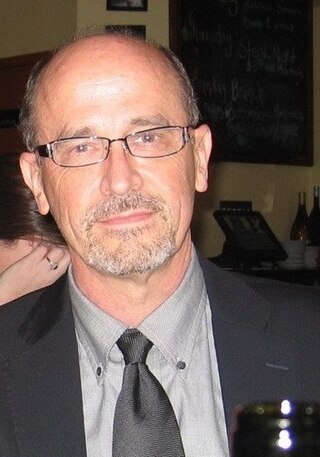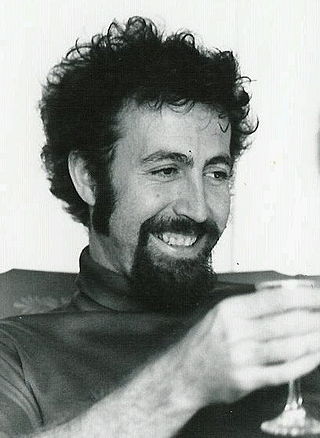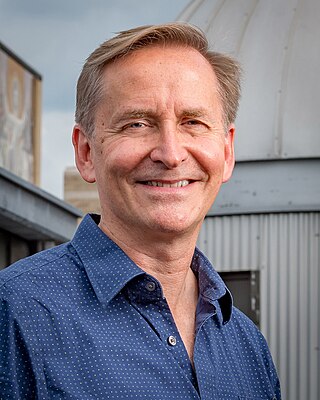
In cosmology, the cosmological constant, alternatively called Einstein's cosmological constant, is a coefficient that Albert Einstein initially added to his field equations of general relativity. He later removed it; however, much later it was revived to express the energy density of space, or vacuum energy, that arises in quantum mechanics. It is closely associated with the concept of dark energy.

Saul Perlmutter is a U.S. astrophysicist, a professor of physics at the University of California, Berkeley, where he holds the Franklin W. and Karen Weber Dabby Chair, and head of the International Supernova Cosmology Project at the Lawrence Berkeley National Laboratory. He is a member of both the American Academy of Arts & Sciences and the American Philosophical Society, and was elected a Fellow of the American Association for the Advancement of Science in 2003. He is also a member of the National Academy of Sciences. Perlmutter shared the 2006 Shaw Prize in Astronomy, the 2011 Nobel Prize in Physics, and the 2015 Breakthrough Prize in Fundamental Physics with Brian P. Schmidt and Adam Riess for providing evidence that the expansion of the universe is accelerating. Since 2021, he has been a member of the President’s Council of Advisors on Science and Technology (PCAST).

A Type Ia supernova is a type of supernova that occurs in binary systems in which one of the stars is a white dwarf. The other star can be anything from a giant star to an even smaller white dwarf.

Robert P. Kirshner is an American astronomer, Chief Program Officer for Science for the Gordon and Betty Moore Foundation, and the Clownes Research Professor of Science at Harvard University. Kirshner has worked in several areas of astronomy including the physics of supernovae, supernova remnants, the large-scale structure of the cosmos, and the use of supernovae to measure the expansion of the universe.
The Supernova Cosmology Project is one of two research teams that determined the likelihood of an accelerating universe and therefore a positive cosmological constant, using data from the redshift of Type Ia supernovae. The project is headed by Saul Perlmutter at Lawrence Berkeley National Laboratory, with members from Australia, Chile, France, Portugal, Spain, Sweden, the United Kingdom, and the United States.

Alexei Vladimir "Alex" Filippenko is an American astrophysicist and professor of astronomy at the University of California, Berkeley. Filippenko graduated from Dos Pueblos High School in Goleta, California. He received a Bachelor of Arts in physics from the University of California, Santa Barbara in 1979 and a Ph.D. in astronomy from the California Institute of Technology in 1984, where he was a Hertz Foundation Fellow. He was a postdoctoral Miller Fellow at Berkeley from 1984 to 1986 and was appointed to Berkeley's faculty in 1986. In 1996 and 2005, he was a Miller Research Professor, and he is currently a Senior Miller Fellow. His research focuses on supernovae and active galaxies at optical, ultraviolet, and near-infrared wavelengths, as well as on black holes, gamma-ray bursts, and the expansion of the Universe.

Adam Guy Riess is an American astrophysicist and Bloomberg Distinguished Professor at Johns Hopkins University and the Space Telescope Science Institute. He is known for his research in using supernovae as cosmological probes. Riess shared both the 2006 Shaw Prize in Astronomy and the 2011 Nobel Prize in Physics with Saul Perlmutter and Brian P. Schmidt for providing evidence that the expansion of the universe is accelerating.

Brian Paul Schmidt is an American Australian astrophysicist at the Australian National University's Mount Stromlo Observatory and Research School of Astronomy and Astrophysics. He was the Vice-Chancellor of the Australian National University (ANU) from January 2016 to January 2024. He is known for his research in using supernovae as cosmological probes. He previously held a Federation Fellowship and a Laureate Fellowship from the Australian Research Council, and was elected a Fellow of the Royal Society (FRS) in 2012. Schmidt shared both the 2006 Shaw Prize in Astronomy and the 2011 Nobel Prize in Physics with Saul Perlmutter and Adam Riess for providing evidence that the expansion of the universe is accelerating.

Nicholas B. Suntzeff is an American astronomer and cosmologist. He is a university distinguished professor and holds the Mitchell/Heep/Munnerlyn Chair of Observational Astronomy in the Department of Physics & Astronomy at Texas A&M University where he is director of the Astronomy Program. He is an observational astronomer specializing in cosmology, supernovae, stellar populations, and astronomical instrumentation. With Brian Schmidt he founded the High-z Supernova Search Team, which was honored with the Nobel Prize in Physics in 2011 to Schmidt and Adam Riess.

SN 1993J is a supernova observed in Bode's Galaxy. It was discovered on 28 March 1993 by F. Garcia in Spain. At the time, it was the second-brightest type II supernova observed in the twentieth century behind SN 1987A, peaking at a visible apparent magnitude of 10.7 on March 30, with a second peak of 10.86 on April 18.

Mark M. Phillips (born March 31, 1951) is an American astronomer who works on the observational studies of all classes of supernovae. He has worked on SN 1986G, SN 1987A, the Calán/Tololo Supernova Survey, the High-Z Supernova Search Team, and the Phillips relationship. This relationship has allowed the use of Type Ia supernovae as standard candles, leading to the precise measurements of the Hubble constant H0 and the deceleration parameter q0, the latter implying the existence of dark energy or a cosmological constant in the Universe.

Christopher Stubbs is an experimental physicist on the faculty at Harvard University in both the Department of Physics and the Department of Astronomy. He is the Dean of Science at Harvard University and a former chair of Harvard's Department of Physics.

Robert A. Schommer was an American observational astronomer. He was a professor at Rutgers University and later a project scientist for the U.S. office of the Gemini Observatory Project at the Cerro Tololo Inter-American Observatory (CTIO) in Chile. He was known for his wide range of research interests, from stellar populations to cosmology.

Mario Andrés Hamuy Wackenhut is a Chilean Astronomer and Professor of Astronomy at the University of Chile and Cerro Calan Observatory. He is well known for his observational work on all classes of supernovae, especially the use of Type Ia and Type II supernovae as measures of cosmic distance.

The Calán/Tololo Supernova Survey was a supernova survey that ran from 1989 to 1995 at the University of Chile and the Cerro Tololo Inter-American Observatory to measure a Hubble diagram out to redshifts of 0.1. It was founded by Mario Hamuy, José Maza Sancho, Mark M. Phillips, and Nicholas B. Suntzeff in 1989 out of discussions at the UC Santa Cruz meeting on supernovae on how to improve the Hubble diagram using Type Ia supernovae. It was also motivated by the suggestion of Allan Sandage to restart a supernova survey after the Sandage and Tammann survey failed due to poor quality photographic plates in 1986. The Survey built on the original supernova survey of Maza done at the f/3 Maksutov Camera at the Cerro Roble Observatory of the University of Chile between 1979 and 1984. The Survey used the CTIO Curtis Schmidt telescope with IIa-O photographic plates, each plate covering a field of 25 sq-deg on the sky. The plates were developed and sent to Santiago Chile the next morning and searched for supernovae at the Department of Astronomy at the University of Chile. Any supernova candidates were then observed the next night using the 0.9m telescope at CTIO with a CCD camera. This was one of the first studies done in astronomy where the telescope time was scheduled to observe objects not yet discovered.

Pilar Ruiz-Lapuente is an astrophysicist working as a professor at the University of Barcelona. Her work has included research on type Ia supernovae. In 2004, she led the team that searched for the companion star to the white dwarf that became supernova SN 1572, observed by Tycho Brahe, among others. Ruiz-Lapuente's research on supernovae contributed to the discovery of the accelerating expansion of the universe.

Bruno Leibundgut is a Swiss astronomer born in Basel. His work focuses on supernovae and cosmology. He was a member of the High-z Supernova Search Team and participated in the planning, development and start of the operations of the Very Large Telescope.

Peter M. Garnavich is a faculty member of the Department of Physics and Astronomy at the University of Notre Dame. His primary research area is the study of supernovae and their diversity. He has also studied gamma ray bursts and cataclysmic variable stars. Garnavich is a member of a supernova search team that contributed to the discovery of dark energy in 1998. At Notre Dame, Garnavich has developed and participated in collaborations using the Spitzer Space Telescope, the Large Binocular Telescope, the Hubble Space Telescope, and the Kepler Space Telescope. He was named a fellow of the American Astronomical Society (AAS) in 2024.
The Hydrogen Intensity and Real-time Analysis eXperiment (HIRAX) is an interferometric array of 1024 6-meter (20ft) diameter radio telescopes, operating at 400-800MHz, that will be deployed at the Square Kilometer Array site in the Karoo region of South Africa. The array is designed to measure red-shifted 21-cm hydrogen line emission on large angular scales, in order to map out the baryon acoustic oscillations, and constrain models of dark energy and dark matter.
Maryam Modjaz is a German-American astrophysicist who is a professor and Director of Equity and Inclusion at the New York University. Her research considers the death of massive stars. She was awarded an Alexander von Humboldt Foundation Fellowship in 2018, which she spent at the Max Planck Institute for Astronomy.



















